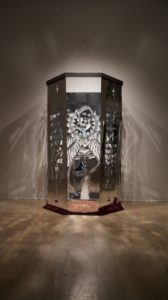Indigenous activism served as the spark for Open Space’s newest exhibition, LAND BACK.
Open Space Indigenous curator Eli Hirtle was particularly moved by the activism that led to occupations and blockades across the province—and, indeed, the country—in solidarity with the Wet’suwet’en resistance to the Coast GasLink pipeline. Hirtle had the opportunity to visit the Unist’ot’en resistance camp in 2013.
“It was one of those experiences—doing the Free Prior and Informed Consent protocol while crossing the bridge, that really had a deep impact on me and my life,” says Hirtle, “and so those are the roots of this exhibition, for myself and my own political activism.”

The pandemic hit shortly after Hirtle had the idea for this exhibit; throughout the spring and summer, Open Space experimented with different ways to engage with their community, including a colouring book and streaming series (both available on Open Space’s website). In line with this new way of showing art in a world still grappling with COVID-19, Hirtle decided to stagger the installation of each piece over a period of six weeks.
“I started to gravitate toward this idea of things kind of unfolding and gradually taking shape over a period of time,” he says, “which would make things safer for everybody, but it would also replicate… the energy that I have felt at occupations and blockades… where it’s never static, there’s always an ebb and flow of bodies [and] energy and resources, usually in response to corporate or police or military action.”
This, Hirtle hopes, will allow for each piece in LAND BACK to be spotlighted individually, while also presenting the works as dynamic with each new installation. In choosing artists to feature in the exhibit, Hirtle wanted to highlight those who were affected by and participated in activist efforts.
“Having this kind of position at Open Space, and the access to the resources that come with that, I really wanted to work with artists that I knew were out at blockades and were supporting these actions and who were really affected by what was happening on the ground,” says Hirtle.
The first work installed was by Diné artist Nicole Neidhardt, who opened the showcase with a hand-cut mirror mylar “transporter.”
“[The piece has] stencils cut out of the mirror mylar and there is a dramatic, intentional use of light in the space [that] casts off shadows of the templates around the piece, the wall and the floor,” says Hirtle. “It’s been really incredible to see people step inside of it, to experience it in a tangible way.”
While the name LAND BACK has been almost sloganized, Hirtle also recognized the words as a “rallying cry.”
“It is an open door for people… [including] Indigenous folks, settlers… BIPOC… immigrants and refugees to think about the lands that they’re on and their relationships and responsibilities to that land, to the ancestors of that land and to the stewards of that land.”
LAND BACK
Until Saturday, January 16
Open Space
openspace.ca
